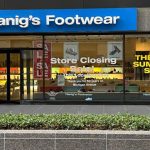J.C. Penney’s stock plunged nearly 14 percent on Friday at $4.55 per share after the department store operator reported weak comparable sales and a massive net loss in the first quarter.
Marvin R. Ellison, chairman and chief executive officer, said, “We continue to make encouraging progress in the company’s competitive and financial position despite our top-line performance during the first quarter. While February was a very challenging month for J.C. Penney and broader retail, we are pleased with our comp store sales for the combined March and April period, which improved significantly versus February. The recent sales trends, combined with the improvement in women’s apparel and our growth initiatives led by Sephora inside J.C. Penney, jcp.com and major appliances, provide us with the confidence to maintain our sales guidance for the full year. Additionally, our investment in pricing and merchandising systems allowed us to deliver a 10 basis point increase in gross margin over last year, in light of the growth in appliances and e-commerce. Also, through our de-leveraging efforts and improved financial condition, we earned yet another credit rating upgrade this quarter. Our teams remain committed to executing on our strategic growth initiatives, and we are confident in our ability to drive sustainable growth and long-term profitability for J.C. Penney.”
The company reported net sales of $2.7 billion in the first quarter of 2017 compared to $2.8 billion last year. Comparable-store sales were down 3.5 percent for the quarter.
Home, Sephora, Fine Jewelry and Salon all comped positively, and were the company’s top performing divisions during the quarter. Geographically, the Southwest and Southeast were the best-performing regions of the country.
For the first quarter, gross margin was 36.3 percent of sales, an increase of 10 basis points compared to the first quarter last year. Gross margin was positively impacted by improved selling margins throughout the quarter, which was partially offset by the continued growth in the company’s online and major appliance businesses.
SG&A expenses for the quarter declined $29 million to $843 million, or 31.2 percent of sales. These savings were primarily driven by lower marketing, store controllable costs and incentive compensation.
For the first quarter, the company’s net loss was $180 million, or (58 cents) per share. This includes the following items:
- $220 million, or approximately (71 cents) per share, of restructuring charges associated with store closing announcement and voluntary early retirement program
- $17 million, or approximately 6 cents per share, of benefit from the tax impact from other comprehensive income allocation and other
- $4 million, or approximately 1 cent per share, of benefit from primary pension plans.
Adjusted net income improved $116 million, or 38 cents per share, to 6 cents per share for the first quarter this year compared to a net loss of $97 million, or (32 cents) per share, last year. Adjusted net income for the first quarter of 2017 and 2016 includes the sale of operating assets, which totaled $117 million and $8 million, respectively.
EBITDA was $40 million for the first quarter 2017 compared to $176 million for the same period last year. Adjusted EBITDA for the quarter improved $102 million, or 67 percent, to $255 million compared to the first quarter last year.
Inventory at the end of the first quarter 2017 was $2.95 billion, an increase of 0.8 percent compared to the end of the first quarter last year. Approximately 300 basis points of the increase was driven by floor samples for appliance showrooms and higher inventory levels to support the company’s continued investment in new Sephora shops.
The company completed the sale of its Buena Park distribution facility in March for a net sales price of approximately $131 million, and recorded a net gain of approximately $111 million in the first quarter associated with the sale of this facility.
Cash and cash equivalents at the end of the first quarter were $363 million. During the quarter, the company utilized available cash on hand to retire $220 million of outstanding bonds that matured in April. As previously stated earlier this week, the company launched cash tender offers to purchase up to $300 million aggregate principal amount on portions of its 2018 and 2019 outstanding bonds. The company ended the quarter with a liquidity position of approximately $2.4 billion.
In March, Standard & Poor’s Rating Services upgraded the company’s credit rating one notch to B+ and affirmed their positive outlook on the company.
Outlook
The company reaffirmed its 2017 full-year guidance. As a reminder, fiscal 2017 is a 53-week year, which has been incorporated into the full-year guidance, with the exception of comparable-store sales which are calculated on comparable 52-week basis. The following guidance also includes the expected impact of the company’s previously announced store closures.
The fiscal 2017 full year guidance is reaffirmed as follows:
- Comparable store sales: expected to be minus 1 percent to plus 1 percent
- Gross margin: expected to be up 20 to 40 basis points versus 2016
- SG&A dollars: expected to be down 1 to 2 percent versus 2016
- Adjusted earnings per share1: expected to be $0.40 cents to 65 cents















